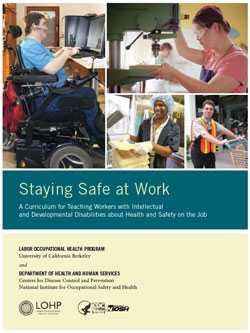Staying Safe at Work
September 2016
DHHS (NIOSH) Publication Number 2016-159

A Curriculum for Teaching Workers with Intellectual and Developmental Disabilities about Health and Safety on the Job
Why Teach Workers with Intellectual and Developmental Disabilities about Health and Safety on the Job?
The rate of workplace injury among employees in vocational rehabilitation programs is more than 60% higher than that of injured workers as a whole (out of every 100 workers in these settings, 5.5 workers get injured on the job as compared to 3.2 out of 100 workers who get injured on the job in general work settings).1
Jobs performed in sheltered employment settings and by workers with intellectual and developmental disabilities (IDD) in general can be hazardous. This is also true for most low-wage workers. Common work activities include light manufacturing, recycling, assembly, janitorial tasks, industrial laundries, landscaping services, and warehouse work. Almost all of these activities have higher than average rates of injury.
In general, most workers lack health and safety training, but workers with IDD often have even fewer options for this training. A needs assessment conducted in 2006 by the Labor Occupational Health Program (LOHP) at the University of California, Berkeley found almost no examples of comprehensive health and safety training being provided to these workers.2 When training does take place, it is typically a supervisor or job coach instructing what to do or not do with regard to a particular activity. Although this kind of instruction is important, it does not teach workers the skills they need to assess new environments and to problem solve when the situation or task changes, or when something unexpected happens. Workers need to learn and practice these skills in a safe environment where the instructor can teach them, and then they can learn from one another.
A Safety and Health Curriculum for Workers with Intellectual and Developmental Disabilities
One reason for the shortage of occupational health and safety training for workers with IDD has been the lack of curriculum for schools, support agencies, and employers. The Staying Safe at Work curriculum will help bridge this gap. Staying Safe at Work is a six-lesson training program designed to teach basic occupational safety and health knowledge and skills to young and older workers, and students with disabilities. The first version of the Staying Safe at Work curriculum was published by the Labor Occupational Health Program (LOHP) at the University of California, Berkeley with support from the National Institute for Occupational Safety and Health (NIOSH). LOHP, a community outreach program of U.C. Berkeley’s School of Public Health, has developed and presented participatory training programs on various workplace health and safety issues for more than 40 years.
The curriculum is intended for supported employment agencies, community vocational rehabilitation programs, high-school transition programs, and other organizations and companies that place in jobs or hire workers with disabilities. The curriculum can help teach students or consumers/employees the foundational job safety and health skills that all workers need. The curriculum uses highly interactive and fun learning activities to teach workplace safety and health skills, which are general, transferable, and can apply across all jobs and industries.
References
- TABLE SNR05. Incidence rate1 and number of nonfatal occupational injuries by industry and ownership, 2014 http://www.bls.gov/iif/oshwc/osh/os/ostb4351.pdf. Accessed July 28, 2016.
- Dewey, R, Promoting the Health and Safety of Individuals with Developmental Disabilities Employed in Mainstream Settings: Report and Recommendations to the National Institute for Occupational Safety and Health (NIOSH), U.S. Department of Health and Human Services, 2006.
Staying Safe at Work – PowerPoint® Slides [35.5 MB] (Internet required for Youtube)
- Page last reviewed: October 3, 2016
- Page last updated: September 21, 2017
- Content source:
- National Institute for Occupational Safety and Health Education and Information Division


 ShareCompartir
ShareCompartir